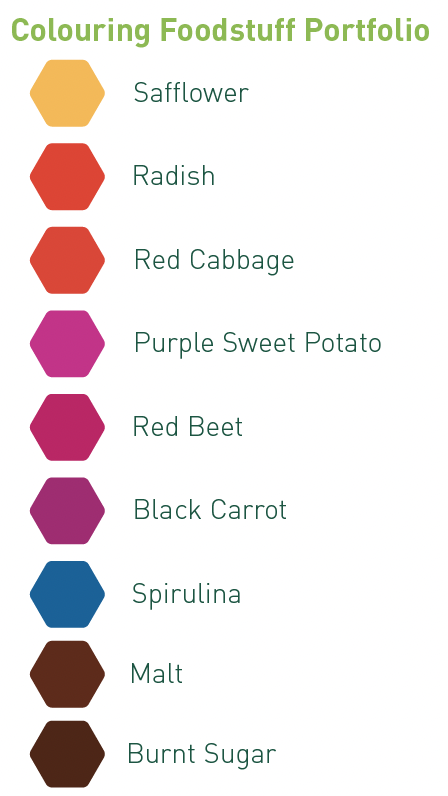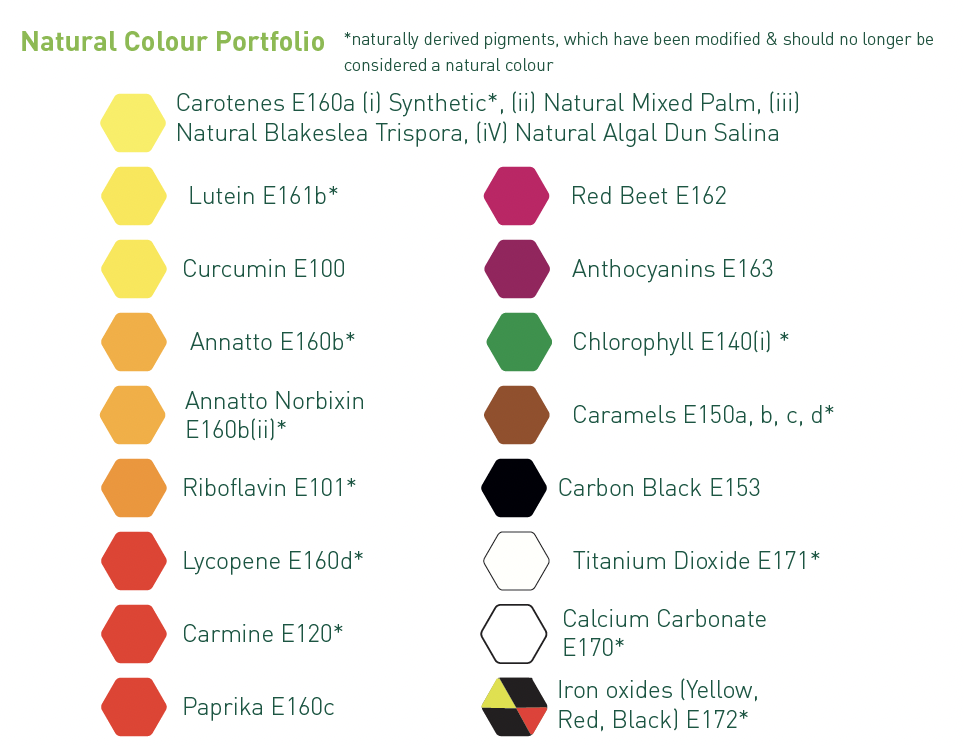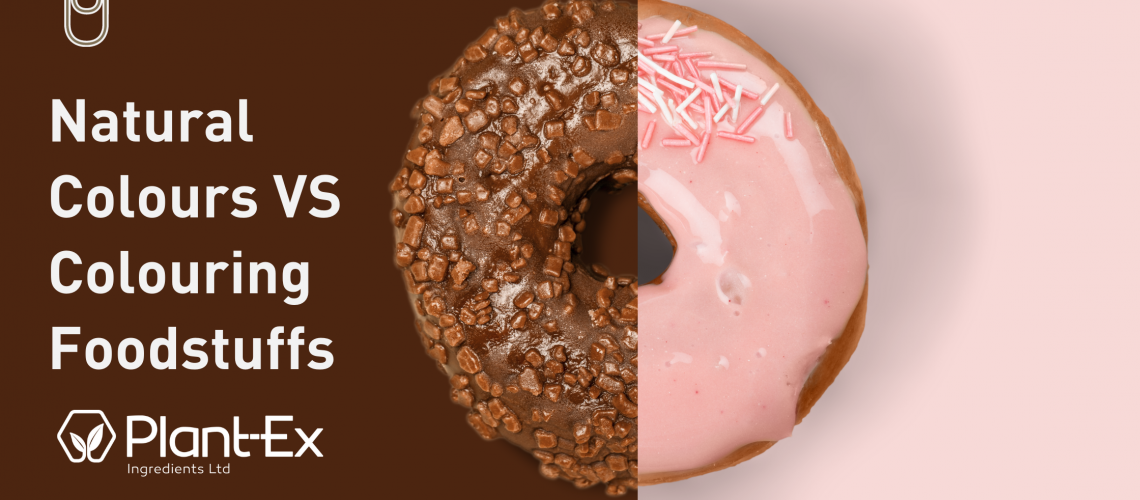Food colours are used to restore, enhance and differentiate food products in a wide variety of applications. Creating eye-catching products is key to standing out in an ever-growing marketplace. With consumers increasingly more health-focused and knowledgeable about food labelling and artificial ingredients, there has been a strong uptake in the use of Clean-Label, natural plant and vegetable-based ingredients, a trend set to continue.
As a specialist manufacturer of food ingredients, Plant-Ex can offer a full-colour portfolio of natural colours alongside a wealth of experience and technical expertise, catering for all industries and applications. From high performance, naturally-derived food colours to Clean-Label food colours to clean label colouring food ingredients, Plant-Ex can offer innovative and stable colour solutions for all applications and labelling demands.
Breakdown of colours
• Artificial Food Colour Additives (E-Number) – Synthetically produced additives used to colour foods, For example, Azo dyes such as Tartrazine E101.
• Natural Food Colour Additives (E-Number) – These are derived from a variety of natural sources and are processed in order to concentrate, enhance and stabilise the colour pigments.
• Colouring Foodstuffs (Clean Label Ingredients) – Simply processed from foods such as fruits, vegetables, plants and spices, which are used to give flavour and colour, along with a clean label declaration.
What are Colouring Foodstuffs?
• Colouring foodstuffs are clean label ingredients that naturally impart colour to food and beverages. They are produced from edible fruits, vegetables, flowers, algae and spices, which have been simply processed without using chemicals or solvents to extract the pigments selectively.
• An example of a Colouring Foodstuff is Saffron, used for many thousands of years to impart a delicate flavour as well as its prized golden yellow colour.
• Based on the principle of minimal processing without using solvents or chemicals, colouring foods are primarily concentrated juices produced from high-quality crops and raw materials, which are then standardised for colour and carefully processed into a range of formats.
• Colouring foodstuffs do not undergo selective extraction of the colour pigments, and they have simply concentrated juices that retain the flavour and nutritive qualities of the source.
• As typical food ingredients, colouring foodstuffs are not considered technological additives and are not regulated under 1333/2008 legislation. Therefore, the labelling of colouring foodstuffs is an ingredient in the product and does not require labelling as a colour or an E-number.
• The criteria for defining a colouring foodstuff can be found in the EU Guidance notes on the classification of food extracts with colouring properties (29.11.2013, Version 1), which was adopted by the European Standing Committee on the Food Chain and Animal Health.
• Colouring foodstuffs have a clean label declaration and are based on natural, edible ingredients recognisable to the consumer. With growing awareness of artificial additives, as well as strong trends towards improving health and eating nutritious foods, colouring foodstuffs have grown in popularity as they are perceived as more natural and healthy options.
• Working with colouring foodstuffs may present challenges when developing new products. They tend to be less stable than typical food colour additives and may require higher dosages to achieve the desired colour shade when compared with their additive counterparts. However, with in house research and development laboratories and applications kitchens, Plant-Ex has built a wealth of knowledge in the use of colouring foodstuffs and is able to offer a range of support.
Colouring Foodstuff Portfolio

Technical Demonstrations:
- Turbidity
- pH
- Heat
- Emulsions and particle size
- Spray drying
- Colour matching
- Solubility
- Dosage
- Applications
- Blending
Colouring Foodstuffs: Pros and Cons
+ Wide portfolio of colour shades in a range of user-friendly formats
+ Clean label, simply processed ingredients
+ Growing consumer demand for clean label, natural ingredients
+ Perceived by the consumer as healthy, such as Spirulina
– Can be difficult to achieve bright/intense colour shades
– Colours are less stable and require careful selection
– Cost in use is higher than with naturally derived colours
– May impart taste at higher dosages
What are Natural Colours?
• A natural colour is a food colour additive that has been derived from a natural source and added to a food or beverage for the primary reason of modifying the colour of the product.
• Plant-Ex’s natural colours are extracted from a wide range of sources, including plants, spices, microorganisms and minerals. High-quality raw materials are selected to produce vibrant and stable colours before undergoing chemical or solvent processing to selectively extract and enrich the pigments responsible for the colour. The result is a highly concentrated and long-lasting colour, which can be tailored to work in a wide range of food and beverage applications.
• By concentrating the pigment in relation to the other components of the source material, Pant-Ex’s natural colours deliver minimal taste to the final food product.
• Able to produce a bright and vibrant array of colour shades, Plant-Ex’s natural colours portfolio has a range suited to every type of food industry application. By utilising in house technical expertise, as well as the latest manufacturing technology and analytical equipment, Plant-Ex can offer innovative colour solutions with excellent performance and cost in use whilst maintaining batch to batch consistency.
• As technological additives, the usage of food colours is regulated under EU legislation 1333/2008, with the specifications for these colours described in EU 231/2012.
• Under EU legislation, colour additives must be labelled according to their function on the back of the pack, and some may carry restrictions on use in certain foodstuffs. For example, ‘colour: E160a’, or ‘colour: Beta Carotene’.
• Some colours, while derived from natural sources, are not considered natural colours due to the extensive processing and modification the pigments have undergone to stabilise or enhance them. Therefore, whilst there is no differentiation of natural and artificial colours on the back of pack labelling, a product using this group of colours may not claim on packaging to be “made using natural colours” but instead could claim “free from artificial colours”.
• For example, Chlorophyll E140 is a natural colour. However, to produce a more vibrant and stable green colour from Chlorophyll, it is necessary to use the chemical process of alkaline hydrolysis, where the magnesium atom is replaced with sodium and copper to modify the shade of the pigment. This results in the formation of Sodium Copper Chlorophyllin E141 (ii) – it is due to this process, Sodium Copper Chlorophyllin is not considered a natural colour even though it is extracted from a natural source.
Natural Colour Portfolio

Naturally derived colours:
+ Bright and intense colour shades for any application
+ Good cost in use
+ Good stability
+ Low flavour impact
– Must be labelled as a colour additive
– Lower consumer appeal for additives or E-numbers
– Some naturally derived colours are not able to be labelled as “natural.”
Technical Support
Talk to our team about the options available and our recommendations which would be given according to the application. Accelerated stability testing can also be undertaken in our laboratories to assist our partners.
